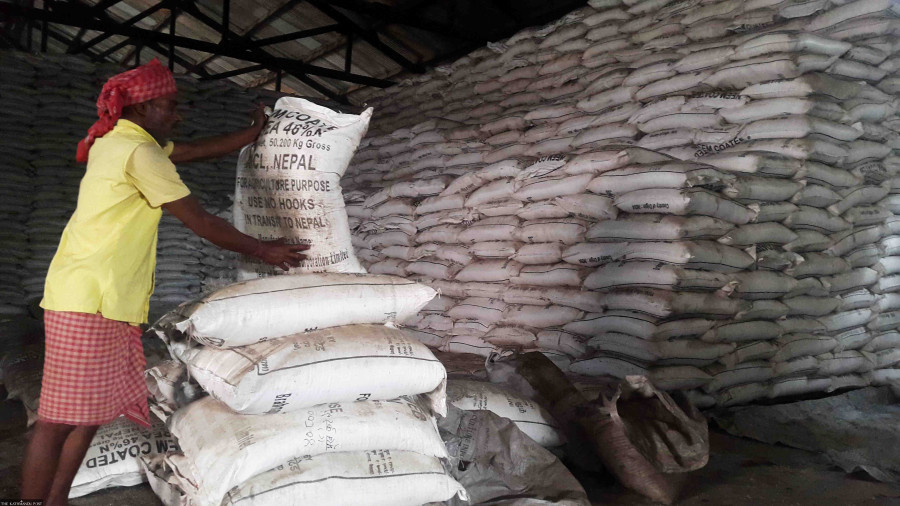Money
Farmers suffer as chemical fertilisers get stalled in warehouses
The agriculture inputs company says the chemical fertiliser distribution has been stalled since a district-wise quota has not been fixed by the provincial government.
Shankar Acharya
Nearly 19,000 tonnes of chemical fertilisers are stalled in the warehouses of the agriculture inputs company in Birgunj due to the failure of the Ministry of Land Management, Agriculture and Cooperatives of the Madhesh Province to fix distribution quotas.
The fertilisers have been stalled at the warehouses at a time when the farmers have begun sowing corn, and spring paddy and start planting sugarcane.
The province has determined the fertiliser quota based on the size of arable land and the number of farmers in a particular district.
According to the agriculture inputs company's regional office in Birgunj, 13,421 tonnes of urea and 5,479 tonnes of di-ammonium phosphate (DAP) are currently stored in the warehouses at different offices in eight districts of Madhesh Province.
Over the past three months, the company has imported a large quantity of urea and DAP through the Birgunj point.
According to officials, 30,000 tonnes of urea was imported from India through a government-to-government arrangement. It was supplied by National Fertilisers Limited, India.
Out of 30,000 tonnes of urea, 11,776 tonnes were received by the Birgunj office.
In the second consignment, the agriculture inputs company imported 30,000 tonnes of urea through a global tender. Of the total 30,000 tonnes of urea, the Swiss-Singapore Overseas Enterprise Company was contracted to import 12,000 tonnes, which it imported from Malaysia.
The third consignment of 20,000 tonnes of DAP was imported from China, which was contracted to the Swiss Singapore Overseas Company. Out of the total 20,000 tonnes, 8,000 tonnes of DAP were received by the regional office in Birgunj.
Alok Kumar, information officer of the Agriculture Inputs Company, said around 17,000 tonnes (14,205 tonnes of urea and 3,312 tonnes of DAP) have already been mobilised in different districts of Madhesh Provence.
The government determines the fertiliser quota from each consignment for each district.
The Madhesh province gets a 30 percent quota of the total imported chemical fertilisers and six other provinces are distributed the remaining 70 percent, based on the size of arable land.
With the Madhesh province having more agricultural land, the province gets more quantity, said Kumar.
Kumar said that the chemical fertilisers' distribution has been stalled as the district-wise quota has not been determined by the ministry of the provincial government.
"The Agriculture Inputs Company cannot distribute the fertiliser directly. Once the provincial ministry determines the quota, the Agriculture Knowledge Centre in the district again fixes the quotas for municipalities and rural municipalities,” Kumar said.
Accordingly, the cooperatives in the municipality and rural municipality are assigned to further distribute the fertilisers to farmers.
Asarfi Sah, president of Farmers' Association, Parsa, said that the farmers are currently in need of fertilisers for sugarcane, maize, spring paddy and vegetables.
“It’s unfortunate that the farmers do not get the fertiliser when they are in need. The concerned body should be serious."
In March, the government jacked up the prices of chemical fertilisers after 10 years to rein in the subsidies, following the stress on the treasury. It, however, was forced to roll back the decision.
According to the Ministry of Agriculture and Livestock Development, the practical demand for chemical fertilisers hovers around 520,000 tonnes, annually. The country's requirement is 520,000 tonnes—310,000 tonnes of urea, 190,000 tonnes of diammonium phosphate (DAP) and 20,000 tonnes of potash.
The import of chemical fertilisers in the last fiscal year stood at 215,000 tonnes, down from 378,000 tonnes in the previous fiscal year. Before that, the annual import of chemical fertiliser used to be more than 400,000 tonnes.
Even though shipments were down by half, the fertiliser import bill crossed Rs22 billion in the last fiscal year, the highest on record, following a sharp rise in prices in the international market.
Government statistics show that the import of chemical fertiliser plunged by more than half in the last fiscal year that ended mid-July 2022 following a five-fold jump in prices.
The price of chemical fertilisers started to increase from the beginning of 2021 due to surging input costs, supply disruptions caused by sanctions (Belarus and Russia), and export restrictions imposed by China, according to the World Bank.
Concerns around fertiliser affordability and availability were further amplified by the war in Ukraine. As matters stand, fertiliser prices have surpassed their 2008 peak.




 8.12°C Kathmandu
8.12°C Kathmandu













